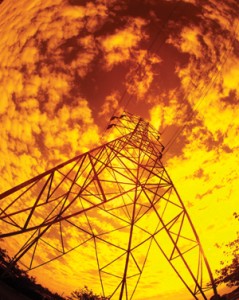
Photo (c) Jupiter Images
“Utility scale” is one of those vague phrases the media, including Electric Consumer, use in stories about the electric utility industry when no other words seem to succinctly suffice. “Utility scale” means something big … really big.
“Utility scale” describes the size and scope of the generation, transmission and distribution equipment required to reliably and economically bring electricity to all Americans. The nation’s electric system is the largest machine ever made. The sheer numbers involved in the resources, facilities and manpower needed to keep it running can make heads spin.
This month, Electric Consumer tries to put “utility scale” into perspective. Here are a series of factoids and graphics, some sobering, some whimsical, to help you better understand how that electric current coursing through the wires in your home gets there and is always there when you need it.
Electricity 101
A crash course in power
Before delving into numbers, here’s a brief look at how electricity gets to your home.
Generation is the process of converting mechanical energy into electrical energy, or electricity. Generation facilities are the first link in the chain in providing electricity to customers.
Electricity is generated in many ways. Coal, natural gas and nuclear are among the top sources in the United States (please see below for a pie chart).
Transmission is the process of carrying high voltages of electricity from generation facilities over long distances. Some cooperatives that provide both generation and transmission functions are called G&Ts. Generation and transmission cooperatives are usually referred to as “power supply cooperatives.” These cooperatives supply power to and are owned by the distribution co-operatives that consumers own.
There are two G&Ts serving Indiana: Wabash Valley Power Association, based in Indianapolis, which serves the REMCs in the northern half of Indiana; and Hoosier Energy REC, based in Bloomington, serving the electric co-ops in the southern half of the state.
In order to move electricity among utilities, an extensive system of high-voltage transmission lines is operated by the nation’s larger utilities and is overseen and by regional organizations under jurisdiction of the Federal Energy Regulatory Commission.
Distribution is the process of carrying electricity from transmission substations to homes and businesses.
Many electric utilities are exclusively distribution utilities — that is, they purchase wholesale power from others to distribute it, over their own distribution lines, to the customer.
Indiana’s 39 consumer-owned and operated REMCs and RECs are distribution cooperatives that maintain the lines and equipment necessary to distribute to their member-owners the electricity that arrives in their service area via transmission lines.
Measuring power
Electricity is measured and billed by kilowatt-hours. A kilowatt-hour is the amount of electricity 10 100-watt light bulbs will use in an hour. Generally, a kilowatt-hour costs around 10 cents in Indiana. A megawatt-hour is equal to 1,000 kWh.
Most residential consumers in Indiana use between 900-1,200 kWh each month.
The size of a power generator — its potential for making electricity — is measured in kilowatts or megawatts. This potential is known as its “capacity,” or “nameplate rating.”
“Capacity factor” is the ratio of actual electricity produced to the maximum it could have produced if operated 100 percent of the time. Capacity factor is normally a percentage.
2.5 Million Miles
Co-op power lines could lasso the moon — several times over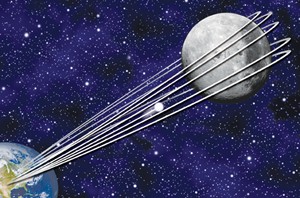
There are 864 individual, independent distribution electric cooperatives in the United States, 39 of them in Indiana.
Collectively, the nation’s consumer-owned co-ops own and maintain 2.5 million miles of power line. That’s 42 percent of the nation’s electric distribution lines covering three quarters of the nation’s landmass.
Put end to end, these power lines running along county roads, through fields and forests and across rural America’s hills and hollows bringing electricity to homes, farms and factories would make five complete roundtrips to the moon — and have plenty left over to light up its dark side!
264,000 Tons in the Air
Transmission lines are a load!
To meet proposed renewable energy mandates, some 10,000 miles of new high-voltage transmission line must be built in the Eastern U.S. alone. Transmission lines carry an electric load between 138,000 and 765,000 volts. But they’re a heavy load unto themselves!
A common large transmission conductor is a giant twisty of 76 strands of aluminum wrapped with 19 strands of steel. In diameter, it’s bigger than the cardboard tube inside a roll of paper towels. Just one foot of this wire weighs 2.5 pounds and costs $3.30.
So, 10,000 miles of new transmission, which usually has four strands of these conductors running together, would weigh 264,000 tons and cost $697 million just for the wire.
48% of Power from Coal
How the meters turn
Almost half the electricity generated in the United States is from coal. (In Indiana, it’s 94 percent.) Fossil fuels and nuclear provide almost all of the nation’s power. Here’s a breakdown of U.S. sources using 2008 figures.
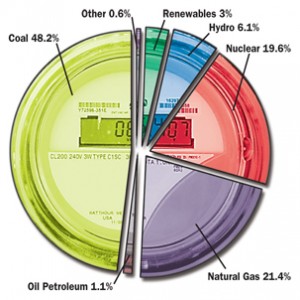
It takes a lot to keep lights on
Hoosier Energy, power supplier to Indiana’s co-ops in the southern half of the state, used a record 4.3 million tons of coal in 2009 at its two coal-fired facilities to help keep your lights on.
That’s an average of 11,780 tons a day. That’s about 118 rail cars a day of coal or 589 truck loads!
59,456 Sq. Miles Gone with the Wind
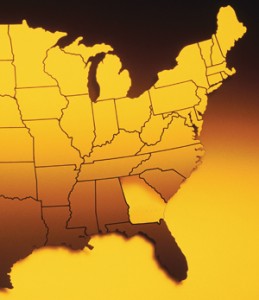
Wind farm the size of Georgia needed to replace coal
Some folks in the media, in Washington and elsewhere seem to think we can shut down all the coal plants in the United States and replace them with wind. What would that take?
U.S. electric output from coal is about 2 billion megawatt-hours annually. To make that much electricity, we need generators capable of producing 228,311 megawatts running 100 percent of the time. Assuming wind turbines reach their maximum potential an average of only 30 percent of the time, we’d need 761,035 MW of wind capacity.
The 2007 average utility-scale turbine could produce 1.6 MW. So, to replace coal power plants, we would need 475,647 average sized turbines. According to a Wind Vision analysis, wind turbines can produce 12.8 MW per square mile allowing for adequate space between wind turbines. So, that amount of capacity would require 59,456 square miles. That’s a wind farm the size of the entire state of Georgia.
Of course, the actual footprint for each turbine is much smaller because the land between turbines is usable for agriculture and the like. And while wind turbine sizes are getting bigger, now up to 5 MW, this does not account for additional issues such as intermittency and necessary transmission lines. Plus, if we’re going to totally replace coal and rely on wind for half our nation’s power, we need to consider additional peaking natural gas plants we can fire up quickly for backup when the wind doesn’t blow enough over the entire region, such as on hot summer days when consumers want to use air conditioners.
$171,849.30 in Cold, Hard Cash
No wonder batteries aren’t included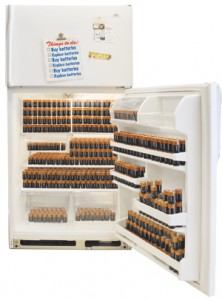
To give you an idea of the amount of real energy that comes into your home via your electric co-op for about 10 cents per kilowatt-hour, imagine trying to run your home on batteries.
A regular D-cell battery, like those used in flashlights, can produce a maximum of 12 amps an hour at 1.5 volts. This equals a total output of 18 watts for one hour. After that, the battery would be dead.
The average refrigerator uses about 250 watts an hour. This means that it would take 14 D batteries to run the average refrigerator for one hour. At this hourly rate, it would take 336 batteries to power a refrigerator each day; 2,352 batteries to power it for a week; and 122,640 batteries for a year!
We found an 8-pack of a popular brand of alkaline D batteries selling for $10.48 at one of the big home improvement stores. With Indiana sales tax, that comes to $171,849.30 for a year of batteries to run just a refrigerator.
(Sure, there are rechargeable batteries. But, if you’re going to use AC power to recharge a bank of batteries, why not just plug in your fridge in the first place and avoid the trouble and expense?)
This is a simplified example, but it illustrates why coming up with an affordable battery efficiently able to power an electric car has been so elusive, and why there is yet no “utility scale” storage of electricity. Electricity must be used when it’s created.
39 Co-Ops/89 Counties
Electric cooperatives cover the state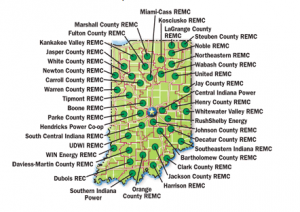
A lot of electric consumers only know their co-op by “REMC” — short for Rural Electric Membership Corporation. But there are 39 electric co-ops in the state, serving more than 500,000 homes, farms and businesses in parts of 89 of Indiana’s 92 counties. Each is an independent, local, not-for-profit utility owned and controlled by its consumers. Here’s a map:
3.14 Orbits
Co-op power lines out of this world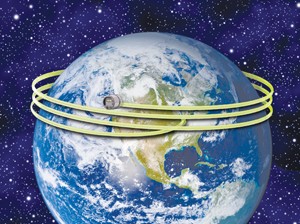
To serve their rural and suburban consumers, Indiana’s 39 electric co-ops own and maintain almost 60,000 miles of energized power lines. Placed end to end, 60,000 miles of line would encircle the Earth at Indiana’s latitude over three times!
On Route 66
Average co-op crew could get its kicks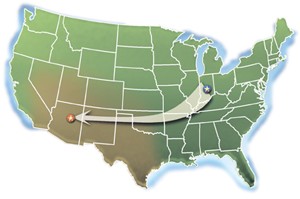
If you took that 60,000 miles of energized line the 39 co-ops in Indiana own and maintain, and divided it evenly, it would come to about 1,540 miles of line for each co-op in the state.
Take 1,540 miles of line stretched end to end, and it would run from Indianapolis all the way to Winslow, Ariz. That also means every journeyman-lineman in the state is responsible for an average of about 250 miles each.
$9.3 Million in Spare Change
Consumers generous in giving to Operation Round Up funds
Hard to believe a little spare change each month could add up to so much and do so much good! But the 26 electric co-ops in Indiana that have Operation Round Up programs have collectively granted $9.3 million to worthy causes throughout their Hoosier communities since the national co-op program came to Indiana in 1995.
The 181,000 consumers participating voluntarily let their co-op round up their monthly electric bill to the next whole dollar. That 25, 50, 75 cents or whatever from each is pooled into a special separate trust fund or existing community charitable fund, depending on how each co-op has set up the program. A local trust fund board then accepts applications and makes grants.
Richard G. Biever is senior editor of Electric Consumer. Sources for this article included the National Rural Electric Cooperative Association, Indiana Statewide Association of Rural Electric Cooperatives, U.S. Energy Information Administration, Hoosier Energy REC, and the Wyoming electric cooperative publication, WREN.



